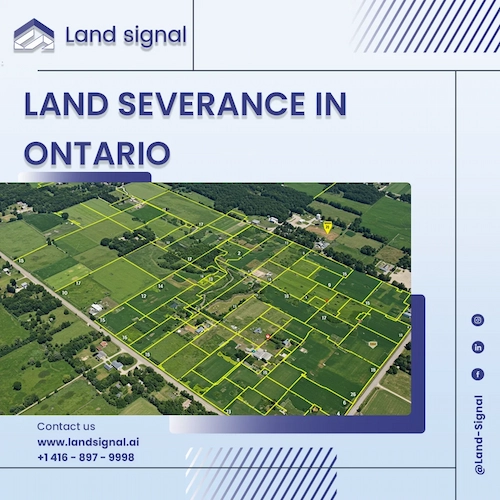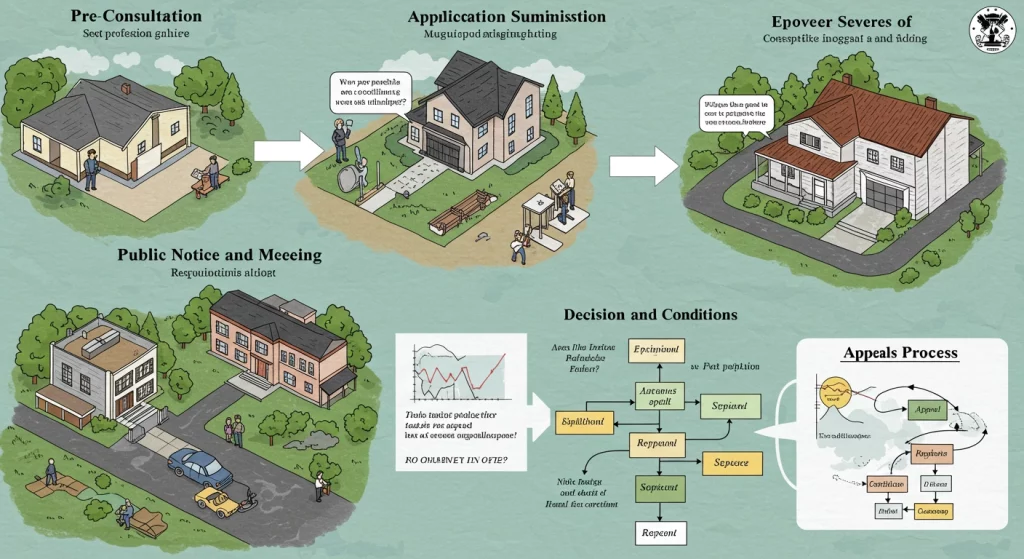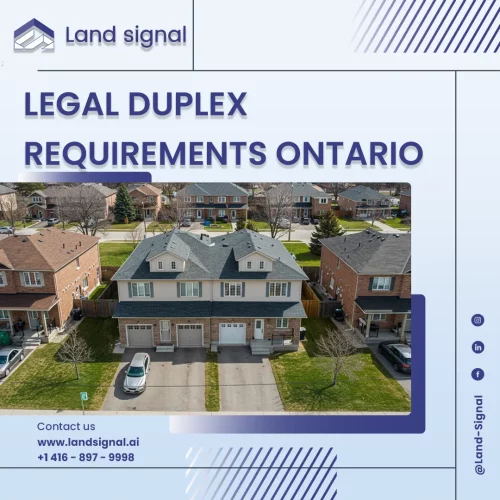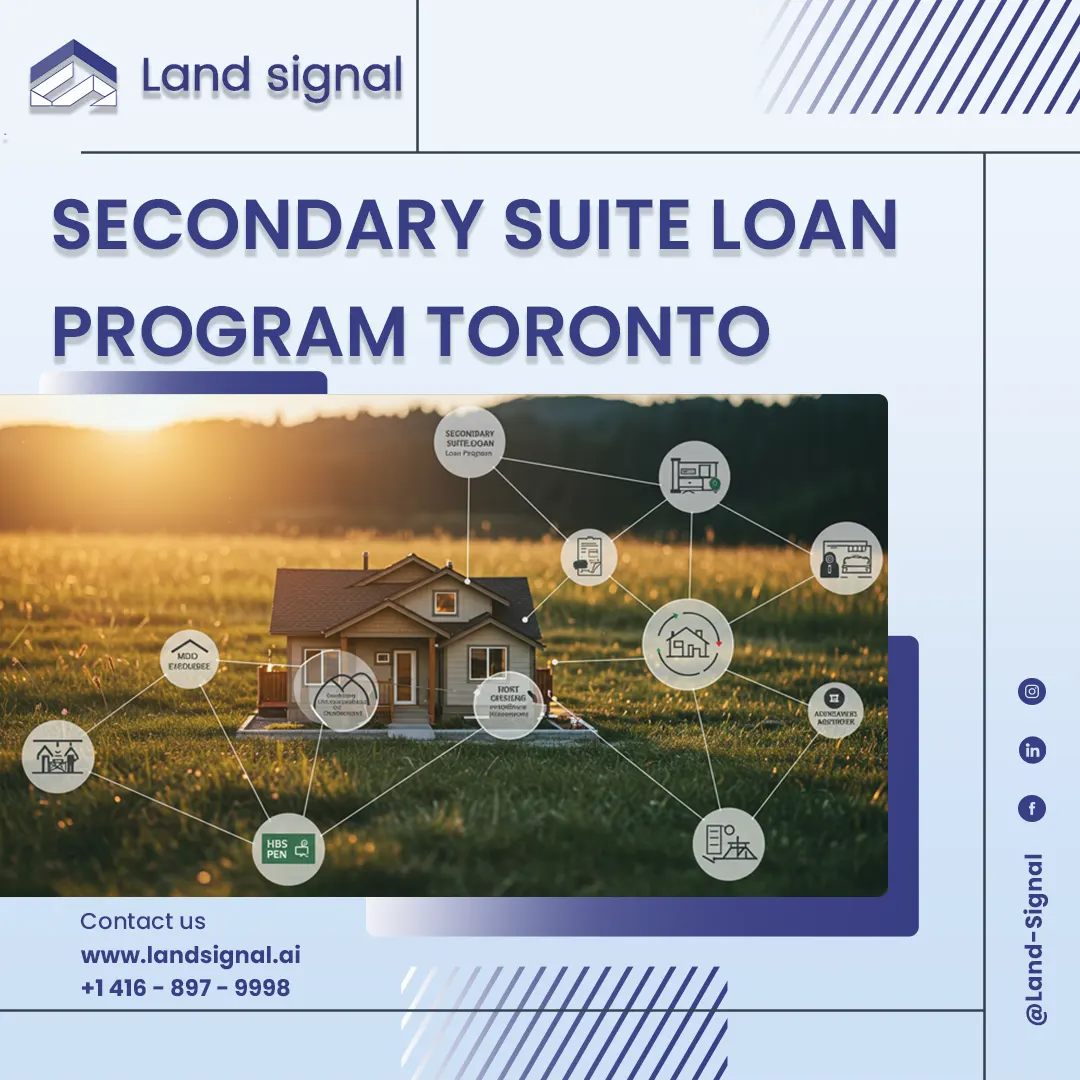Land severance, the legal process of dividing a single property into two or more separate parcels, is a complex undertaking governed by provincial legislation and municipal regulations. In Ontario, this process is regulated by the Planning Act and overseen by local municipalities. Within the City of Toronto, land severance applications are subject to the city’s Official Plan, zoning bylaws, and the decisions of the Committee of Adjustment.
Successfully navigating land severance requires a deep understanding of Official plan, planning requirements, zoning by-laws, municipal approvals, and permit requirements. Land Signal specializes in helping property owners through every stage of the severance process, from assessing feasibility to obtaining necessary permits. Whether you’re looking to maximize your property’s potential or create new development opportunities, our expert team ensures a smooth and compliant severance process.
This guide explores the land severance process in Ontario, focusing on the unique challenges of lot severance in Toronto. It covers key legal frameworks, procedural steps, potential obstacles, and costs, helping property owners make informed decisions—whether to increase property value, create development opportunities, or optimize land use.
Start Your Project with Confidence
At Land Signal, we assist with construction and renovation permits, as well as Garden House and Laneway Suite designs. Let our experts guide you through every step.
What is Land Severance in Ontario?
Land severance in Ontario refers to the legal division of a single parcel of land into two or more distinct lots. This process is governed by the Planning Act, which delegates authority to municipalities to oversee and regulate land severance applications within their jurisdictions.
The Act aims to ensure that land divisions are consistent with planned growth, environmental protection, and the provision of adequate municipal services. A severance is required whenever a property owner intends to create a new lot, whether for sale, development, or personal use.
It’s important to distinguish between a severance and a subdivision. While both involve dividing land, a subdivision typically creates multiple lots, often for a planned development or community, and involves a more complex and extensive approval process.
Severances, on the other hand, are generally for creating a smaller number of lots, often one or two, and typically involve less complex procedures. Understanding the distinction between these two processes is critical for choosing the correct application path. Failing to obtain the necessary approvals for a severance can result in legal penalties and complications with property ownership.
The Process of Land Severance in Ontario
The land severance in Ontario process involves several key stages, each requiring careful attention to detail and adherence to specific regulations. Navigating these stages effectively is essential for a successful application.
Pre-Consultation
Before formally submitting a land severance application, pre-consultation with the local municipal planning department is highly recommended. This crucial step allows applicants to discuss their proposal with planning staff, gain insights into local bylaws and policies, and identify potential issues or challenges early in the process. Pre-consultation provides an opportunity to understand the specific requirements for the proposed severance, including zoning regulations, servicing requirements, and environmental considerations.
This proactive approach can help avoid costly revisions or delays later in the application process. Discussions with planning staff can also help determine the feasibility of the proposed severance and identify potential solutions to anticipated challenges. This stage often involves submitting a preliminary concept plan for review and feedback.
Read Also: Home Building Cost Calculator Ontario
Application Submission
Once the pre-consultation phase is complete and the necessary information has been gathered, the formal application for land severance can be submitted to the committee of adjustment. The application package must be complete and accurate, including all required documentation, such as surveys, site plans, architectural plans, elevations of both proposed buildings, and supporting reports.
The application form itself requires detailed information about the existing property, the proposed lots, and the intended use of the severed lands. Accurate and detailed information is crucial for avoiding delays and ensuring a smooth review process.
Incomplete or inaccurate applications can be rejected, requiring resubmission and potentially delaying the project. It’s essential to follow the municipality’s specific application guidelines and ensure all required fees are paid.
Public Notice and Meeting
After the application is deemed complete, the municipality will issue a public notice of the proposed severance. This notice is typically posted on the property, and formal letter including all variances from zoning by-law will be sent to 200 feet radius neighbors, providing an opportunity for neighbors and community members to review the proposal and express their opinions.
A public meeting will be scheduled to discuss the application and address any concerns raised by the public. This meeting provides a platform for open dialogue and allows the applicant to present their case and respond to questions. Public input is considered by the COA members when making a decision on the application. The applicant should be prepared to address potential concerns and provide clear and concise explanations of the proposed severance.
Decision and Conditions
Following the public consultation period, the municipality will review the application, considering all relevant factors, including zoning bylaws, servicing requirements, environmental impacts, other Neighbourhood lot conditions and public input. The municipality will then issue a decision, either approving, rejecting, or approving with conditions. Conditions of approval may include requirements for servicing, access, landscaping, or other mitigating measures to address potential impacts.
The decision notice will outline the reasons for the decision and any conditions that must be met. It’s essential to carefully review the decision notice and understand all conditions of approval.
At this stage, it is highly recommended to hire an architect or planner who is an expert in this matter. They can prepare the necessary documents, negotiate with municipal planning staff, and represent you in meetings
Please note that the approval decision at this stage is not binding. Neighbours, city staff, or the local councilor may file an appeal; however, they are required to pay an appeal fee, which starts at $400.
Appeals Process
If the application is rejected or the applicant disagrees with the conditions of approval, there is an appeals process available. Appeals are typically made to the TLAB (Toronto local appeal body) in Toronto area and (OLT) Ontario land tribunal independent provincial body that reviews land use planning decisions.
The appeals process involves submitting a formal appeal to the LPAT within a specified timeframe, outlining the grounds for the appeal and providing supporting evidence. They will review the appeal and may hold a hearing to consider the arguments presented by the applicant and the municipality. The OLTs decision is binding, and there are limited options for further appeals.
You need to hire Land tribunal lawyer and planner to provide document and present you in meeting.
Specifics of Lot Severance in Toronto
Lot severance in Toronto applications are subject to specific regulations and procedures outlined in the city’s Official Plan, zoning bylaws, and the decisions of the Committee of Adjustment.
Toronto’s Official Plan and Zoning Bylaws
The City of Toronto’s Official Plan provides a framework for managing growth and development within the city. Zoning bylaws implement the Official Plan at a more detailed level, regulating land use, building heights, setbacks, and other development standards. Land severance applications must conform to both the Official Plan and the applicable zoning bylaws. Understanding these regulations is crucial for determining the feasibility of a proposed severance. Non-conformity with these regulations can lead to application rejection.
Toronto’s Committee of Adjustment
The Committee of Adjustment is a quasi-judicial body that considers applications for minor variances from the zoning bylaws and consents to severances. The Committee has the authority to grant relief from certain zoning restrictions if the applicant can demonstrate that the proposed severance meets specific criteria, such as being minor in nature, desirable for the appropriate development or use of the land, and maintaining the general intent and purpose of the zoning bylaw and the Official Plan.
Applications to the Committee of Adjustment require a formal application process, including submitting detailed plans and supporting documentation. A hearing is typically held where the applicant can present their case and respond to questions from the Committee.
Common Challenges in Land Severance in Ontario and How to Address Them
Several common challenges can arise during the lot severance in Toronto process. Understanding these challenges and developing strategies to address them is essential for a successful application.
Zoning and Land Use Restrictions
Zoning bylaws may restrict the type and density of development permitted on a property, potentially limiting the feasibility of a severance. Addressing this challenge may involve seeking a minor variance from the Committee of Adjustment or exploring alternative development options that conform to the existing zoning.
Committee of Adjustment Rejections
The Committee of Adjustment may reject a severance application if it does not meet the required criteria. Addressing a rejection may involve revising the application to address the Committee’s concerns, appealing the decision to the LPAT, or exploring alternative development options.
Opposition from Neighbors and Community Groups
Neighboring property owners or community groups may oppose a severance application due to concerns about increased traffic, density, or impacts on neighborhood character. Addressing community opposition may involve open communication with neighbors, revising the application to mitigate potential concerns, or participating in mediation processes.
A notification letter will be sent to properties within a 200-foot radius of the house; however, the committee places the most weight on the opinions of adjacent and rear property owners. Therefore, it is highly recommended to speak with your neighbors in advance and address any concerns they may have before the meeting.
Heritage and Environmental Restrictions
Properties located in heritage districts or environmentally sensitive areas may be subject to additional restrictions that can impact the feasibility of a severance. Addressing these restrictions may involve consulting with heritage or environmental specialists, modifying the application to minimize impacts, or seeking approvals from relevant authorities.
Key Requirements and Considerations for Land Severance Ontario
Several key requirements and considerations must be addressed in any land severance Ontario application.
Zoning Requirements
The proposed severance must comply with the local zoning bylaw regulations regarding lot size, setbacks, permitted uses, and other development standards. Zoning bylaws dictate how land can be used and developed within a municipality. These regulations are designed to ensure compatible land uses, protect environmental features, and maintain the character of neighborhoods. Variances from zoning bylaws may be possible through an application to the Committee of Adjustment, but require demonstrating that the proposed variance is minor, desirable, and maintains the general intent and purpose of the bylaw. It’s crucial to carefully review the applicable zoning bylaw before submitting a severance application.
Servicing Requirements
Adequate servicing, including water supply, sewage disposal, and stormwater management, must be available for the proposed lots. This may involve connecting to existing municipal services or installing private sewage systems. Servicing requirements are essential for ensuring the health and safety of future residents and protecting the environment. The capacity of existing infrastructure must be considered to ensure that new lots do not overload the system. Meeting servicing requirements can be a significant cost factor in the severance process. Proof of sufficient servicing capacity must be provided with the application.
Access and Road Access
Each severed lot must have safe and adequate access to a public road. This may involve creating new access points or upgrading existing roads. Access requirements ensure that emergency vehicles can reach the property and that residents have convenient access to transportation networks. The design and location of access points must consider traffic flow, sightlines, and pedestrian safety. Meeting access requirements may involve road widening, intersection improvements, or the construction of new driveways. Approval from the relevant road authority may be required for any changes to public roads.
Environmental Considerations
The proposed severance must not negatively impact environmentally sensitive areas, such as wetlands, woodlands, or watercourses. Environmental assessments may be required to assess potential impacts and identify mitigation measures. Protecting the environment is a key consideration in the land severance Ontario process. Environmental assessments may involve studies of vegetation, wildlife, soil conditions, and water quality. Mitigation measures may include preserving natural features, implementing erosion control measures, or creating buffer zones. Compliance with environmental regulations is essential for obtaining approval.
Impact on Neighbouring Properties
The proposed land severance Ontario must not negatively impact adjacent properties in terms of privacy, access, or enjoyment of their property. Considerations may include setbacks, landscaping, and noise mitigation. Maintaining good relationships with neighbors is important throughout the land severance Ontario process. Addressing potential concerns proactively can help avoid conflicts and delays. Setbacks, landscaping, and other design features can help mitigate impacts on neighboring properties. Open communication and a willingness to compromise can facilitate a smoother process.
Getting Professional Help
Navigating the complexities of land severance can be challenging. Seeking professional assistance from experienced planners, surveyors, and legal counsel can significantly increase the likelihood of a successful outcome. These professionals can provide expert advice, prepare the necessary documentation, and represent the applicant throughout the process.
Their expertise can help navigate the regulatory landscape, address potential challenges, and streamline the application process. Choosing qualified and experienced professionals is crucial. Clear communication and a well-defined scope of work are essential when engaging professional services.
Call to action for Land Signal
Land Signal provides expert guidance and support throughout the land severance process. Contact us today for a consultation and let us help you navigate the complexities of land severance in Ontario. Our team of experienced professionals can provide tailored advice, manage the application process, and represent your interests effectively. We are committed to helping you achieve your land severance goals. Our expertise can help you navigate the regulatory landscape and achieve success.
Conclusion
Land severance in Ontario, especially in a highly regulated city like Toronto, is a complex process with strict legal requirements, procedural hurdles, and significant financial risks. Attempting to navigate this process without expert guidance can lead to costly delays, rejections, or unforeseen expenses.
To avoid unnecessary financial loss and maximize the chances of success, it is crucial to consult professionals from the beginning. By hiring experts through Land signal, you gain access to sea-soned professionals who can guide you through every step—ensuring compliance, streamlining approvals, and helping you achieve your desired outcome efficiently. Don’t risk setbacks—start with the right team to protect your investment and secure a smooth land severance process







